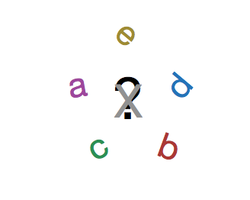Find the deletion
 a, b, c, d and e are five consecutive integers in increasing order. When we delete one of the 5 from the set, then the sum of the numbers would have decreased by 20%
a, b, c, d and e are five consecutive integers in increasing order. When we delete one of the 5 from the set, then the sum of the numbers would have decreased by 20%
Which one of the numbers was deleted from the set?
This section requires Javascript.
You are seeing this because something didn't load right. We suggest you, (a) try
refreshing the page, (b) enabling javascript if it is disabled on your browser and,
finally, (c)
loading the
non-javascript version of this page
. We're sorry about the hassle.
14 solutions
OR u can calculate 20% of total(that is (5a+10)) which can give part contributing 20% that is (a+2) ans.
I did the same xD
The five consecutive numbers can be considered as (x-2), (x-1), x, (x+1), (x+2).
The sum of these 5 numbers is 5x.
The required sum after deleting one of the numbers must be 4x.
This is achieved by performing 5x - x.
In the series considered above, x matches the position c in the proposed problem.
Hence, c is the answer.
simple.. took the example of 1,2,3,4,5
This is very easy.
Reducing the total by 20% is the same as taking away one fifth. If the numbers are going up consecutively, then the middle (median) number will be the only one which is worth exactly one fifth, thus c.
You read that wrong. A reduction of 20% is the same as taking away one fifth.
how do u suppose 20% is the fifth?
let initially no sum were 100 (18,19,20,21,22).after deleting 20 sum is 80(decreased by 20%)
If a=1, b=2, c=3, d=4 and e=5 a+b+c+d+e=15 then c/15 i.e 3/15 is equal to 20% of the total
let the numbers be 1+2+3+4+5 = 15 if we remove a num the sum is decreased by 20% so 20% of 15 = 3
so the deleted number is 3 .
let a,b,c,d,e equals to 1,2,3,4,5 respectively. then 1+2+3+4+5=15. then 15*20%=3. then the answer is c which is equal to 3.
We can use an example: 1+ 2+ 3 + 4 + 5 = 15. 20 percent of 15 is equal to 3. 3 will be the third number in the increasing order a,b,c,d,e if we have taken it to be 1,2,3,4,5.Thus,3=c=answer.
Let S be the sum of all the 5 consecutive numbers. When S is decreased by 20%, it means that the removed number is 20% of S which is 5 S . Luckily, we can get 5 S just using the original equation alone. S 5 S = a + b + c + d + e = a + ( a + 1 ) + ( a + 2 ) + ( a + 3 ) + ( a + 4 ) = 5 a + ( 1 + 2 + 3 + 4 ) = 5 a + 1 0 = 5 ( a + 2 ) = ( a + 2 )
So the removed number is ( a + 2 ) = c .
Consecutive numbers are formed Arithmetic Progression with constant difference equals 1. Initial sum equals A = 2 5 ( a + e ) ; after deletion sum will be B = 2 5 ( a + e ) ∗ 0 . 8 = 2 5 ∗ 1 0 8 ∗ ( a + e ) = 2 ∗ ( a + e ) . Unknown number will be a difference between sums A and B. x = A − B = 2 5 ∗ ( a + e ) − 2 ∗ ( a + e ) = 2 1 ( a + e ) . Use formula to find any member of Arithmetic Progression: a n = a 1 + ( n − 1 ) ∗ d = a + n − 1 ⇒ 2 1 ( a + e ) = a + n − 1 ⇒ 2 1 ( a + ( a + 5 − 1 ) ) = a + n − 1 ⇒ a + 2 = a + n − 1 ⇒ n = 3 , where n is position of member. So third member is c .
2 5 ( 6 ) = 1 5 We have: 1 5 1 , 1 5 2 , 1 5 3 , 1 5 4 , 1 5 5 And we can easily see that five times 3 equals 15, thus, 3/15 = 20%.
We chose sequence of numbers such that sum is 50,that is 8,9,10.11.12. if we remove 10,sum of these numbers will be 40 which is 20 % decreased Ans K.K.GARG,india
so it is c which is to be delated. K.K.GARG,India
Let the 5 consecutive numbers be, 1,2,3,4,5 Its sum will be 15. The sum is decreased by 20% i.e one fifth of the sum = 3. So 3 is deleted or I can say that 'c' is deleted
as the numbers are consecutive and increasing
So b = a + 1, c = a + 2, d = a + 3 and e = a + 4
So the sum = a + ( a+1 ) + ( a+2 ) + ( a+3 ) + ( a+4 ) = 5a+10
After decreasing 20% the sum should be (5a+10)(1 – 20/100) = 4a+8
Deleted number = old sum – new sum = (5a+10) – (4a+8) = a+2
Which is c, so the deleted number is c.